USPS | re: supply
news our suppliers can use
Issue 8
CONTENTS
PATRICK R. DONAHOE NAMED 73RD U.S. POSTMASTER GENERAL AND CEO ›
CUSTOMERS COME FIRST – DONAHOE TESTIFIES AT CONGRESSIONAL HEARING ›
POSTAL SUPPLIER COUNCIL ANNUAL CONFERENCE ›
POSTAL SERVICE YEAR-END REPORTS ONLINE ›
PATRICK R. DONAHOE NAMED 73RD U.S. POSTMASTER GENERAL AND CEO
The Postal Service saw a change in its leadership in early December, with John E. Potter retiring after nearly 10 years as U.S. Postmaster General and CEO, and Patrick R. Donahoe, previously the Deputy Postmaster General and Chief Operating Officer, taking over as the 73rd U.S. Postmaster General and CEO.
Postmaster General Patrick R. Donahoe announced the top executives who will work directly with him in creating a more profitable, nimble U.S. Postal Service, able to compete aggressively in the marketplace and provide exemplary customer service.
“The challenges we face as an organization require that we do many things differently in the coming years and that we drive change at a faster pace than we ever have,” Donahoe said. “We must break down structural challenges to change and empower our executives, managers and employees to achieve at a higher level.”
Donahoe has identified four, core business strategies: strengthening the business to customer channel; improving the customer experience; growing the package business; and becoming a leaner, faster, smarter organization.
Helping the Postmaster General lead the organization’s effort in achieving these goals is the Executive Leadership Team:
- Paul Vogel, President and Chief Marketing/Sales Officer: Vogel is responsible for all product management and development, retail and commercial products and services, commercial sales and will build a strong platform of offerings to meet the demands of an increasingly digital world.
- Megan Brennan, Chief Operating Officer: Brennan has served as Vice President for the Eastern Area for the past four years and will lead all network and process improvements and the allocation of people and resources.
- Joseph R. Corbett, Chief Financial Officer: Corbett continues in his role as CFO, applying financial rigor to Postal strategy development and management decision-making.
- Tony Vegliante, Chief Human Resources Officer: Vegliante continues in his role as CHRO and will drive major efforts relating to the development of the workforce to enable the Poster Service to operate with greater speed and flexibility.
- Ellis Burgoyne, Chief Information Officer: Burgoyne will oversee all systems and data management to help develop new products quickly and fully leverage the network to meet changing customer needs. He leaves a position as Vice President, Southwest Area.
- Mary Anne Gibbons, General Counsel: Gibbons will continue to provide expert legal advice and counsel to decision making and help navigate the many regulations and laws that govern the Postal Service business.
The position of Deputy Postmaster General remains vacant at this time.
"This team is uniquely qualified and capable of leading the Postal Service through a time of great challenges and opportunities,” Donahoe said. “I have great confidence in their ability to work together to drive beneficial change to improve our competitive posture.” Back to Top ›
CUSTOMERS COME FIRST – DONAHOE TESTIFIES AT CONGRESSIONAL HEARING

In early December, Postmaster General Patrick R. (Pat) Donahoe, while still serving as Deputy PMG and COO, told a U.S. Senate subcommittee that one of his highest priorities would be to improve the customer experience, making the Postal Service “leaner, faster and smarter” in the years ahead.
Donahoe said he’s looking at all the ways the Postal Service deals with its customers. “Every interaction with us — with a carrier, a clerk, at a kiosk or online — must be a great one,” he said.
Addressing the current state of the Postal Service, Donahoe acknowledged that the past several years have been challenging. But, he said, there are significant accomplishments that should not be overlooked. He pointed out that the Postal Service achieved $3 billion in spending reductions in fiscal year 2010, for a total of $10 billion since 2008. He also said that despite reaching the lowest career complement since 1970, “Service levels, customer satisfaction and trust in the Postal Service have never been higher.”
Donahoe said the $8.5 billion loss the Postal Service experienced in 2010 was “a stunning number” but that the financial picture was not as grim as it appeared. He noted that were it not for two legally-required payments, $5.5 billion to the Retiree Health Benefits Fund and a $2.5 billion non-cash workers’ compensation adjustment, the loss was less than $500 million, a “significant accomplishment,” especially in light of a 6.6 percent mail volume decline.
“If you look at the aspects of the business within our control, we have done well in responding to economic conditions,” he said. “We have an opportunity to turn the corner and produce regular operating profits.”
He said the legislation introduced by the subcommittee chairman, Sen. Tom Carper (D-DE) would provide the Postal Service with “the flexibility to implement necessary business strategies faster and more effectively” and that the bill had his support.
“My personal vision is that of a profitable, nimble Postal Service that competes for customers and has a well-defined and valued role in an increasingly digital world,” said Donahoe. He added that part of his vision is to ensure the Postal Service “will always be a resource to every American business and be valued and trusted at every American residence.”
He concluded, “Our goal is to remain viable for a long time, and — with the help of the Congress — we will be able to do just that.” Back to Top ›
POSTAL SUPPLIER COUNCIL ANNUAL CONFERENCE
The Postal Service’s mission is to provide reliable, affordable, universal mail service to the nation. But meeting that challenge wouldn’t be possible without a host of suppliers providing mail-processing and transport equipment, communications services, transportation, and the tens of thousands of items needed each day to support USPS operations.
That takes teamwork, and lots of it, to make sure the USPS supply chain remains as efficient and cost effective as possible — a challenge the Postal Supplier Council (PSC) has been meeting for almost 2 decades. And that was the focus earlier this month during the PSC annual conference held at postal headquarters.
With a membership of some 100 suppliers and postal stakeholders, the PSC serves as a forum where suppliers and Postal Service representatives can collaborate to improve efficiencies, processes and policies. The PSC also functions as a sounding board, or test bed, where innovative ideas and changes can be recommended. This helps USPS reduce costs, identify opportunities to create new business, and promote sustainability.
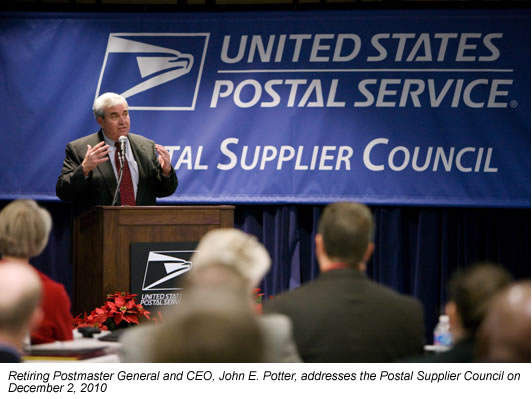
The Postal Supplier Council annual Conference was attended by more than 130 people, including PSC members and their business guests. Supplier members benefited from having the opportunity to hear from postal executives on a variety of topics to help them learn about USPS needs and how to work more efficiently with us.
Topics and speakers included:
- PMG Remarks
John E. Potter, Retiring 72nd U.S. Postmaster General and CEO - Public Policy Update
Marie Therese Dominguez, VP, Government Relations and Public Policy - Mailing and Shipping Focus and Innovations
Paul Vogel, President, Mailing and Shipping Services - Financial Results and Outlook
Joe Corbett, Chief Financial Officer and Executive VP - Postal Executive Panel Discussion
Moderator: Mitzi Betman, VP, Corporate Communications
Panelists:
Tom Day, Senior VP, Intelligent Mail and Address Quality
Deborah Giannoni-Jackson, VP Employee Resource Management
Kelly Sigmon, VP, Engineering
Sam Pulcrano, VP, Sustainability - Supply Management and PSC Accomplishments and Goals Postal Supplier Council Co-Chairs
Susan M. Brownell, VP, Supply Management
Barry Switzer, President & CEO, Ashton Potter - Remarks from 73rd U.S. Postmaster General and CEO
Pat Donahoe, incoming PMG/CEO
Throughout the conference the PSC members were challenged to develop innovative product and service ideas that will support a leaner, faster, smarter and more market-responsive Postal Service. This will play an important role in helping to ensure a viable postal system today and in the future.
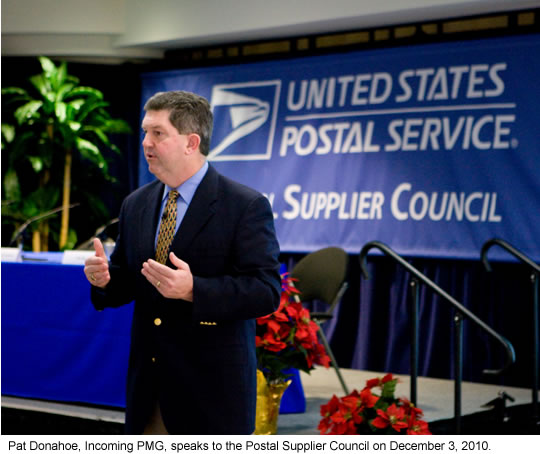
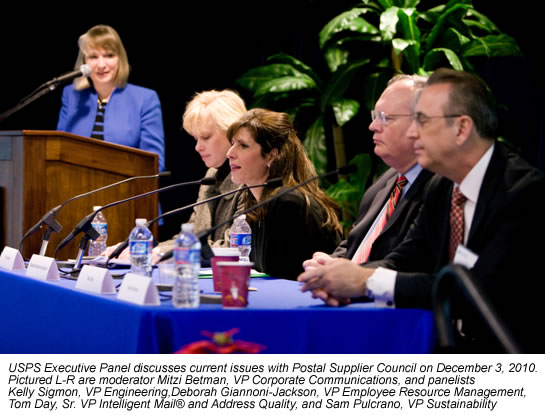
To learn more about the PSC go to http://about.usps.com/suppliers/postal-supplier-council.htm.
POSTAL SERVICE YEAR-END REPORTS ONLINE
This year may be remembered for steep declines in mail volume and revenue, or the continued requirement to prefund retiree health benefits. However, that’s only part of the story.
Among the best stories of 2010 are how employees continued to deliver superior service and kept customer satisfaction at record levels — all while reducing work hours to increase productivity.
The Comprehensive Statement on Postal Operations puts the year in context and provides a broad summary of actions taken over the year, including product and service improvements for customers, initiatives for employees and operational enhancements. Readers also will learn how the Postal Service was able to achieve a better-than-plan operating income, which is discussed in more detail in the Annual Report.
Read more about the challenges and accomplishments in the year-end reports now on usps.com. Click here for the Comprehensive Statement and here for the Annual Report. Back to Top ›
A HOLIDAY GIFT TO BUSINESS MAILERS COURTESY OF THE POSTAL SERVICE – FOREVER STAMPS ARE NOW AVAILABLE ON COILS
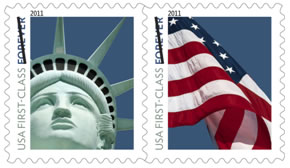
WASHINGTON — Business mailers across the nation will receive a special holiday gift from the U.S. Postal Service this season with the issuance of two, new, First-Class Mail Forever stamps on coils.
The new stamps feature photographs of world-recognized symbols of the United States: the Statue of Liberty and the American flag. The Lady Liberty and U.S. Flag Forever Stamp coils are now on sale at select Post Offices nationwide, online at www.usps.com, and by phone at 1 800-STAMP-24. Forever stamps are always equal in value to the current First-Class Mail one-ounce price. They were first introduced in 2007.
As the name suggests, Forever Stamps can be used to mail a one-ounce letter regardless of when the stamps are purchased or used and no matter how prices may change in the future.
“Our business and residential customers have spoken and we have listened,” said David Failor, executive director, Stamp Services. This is a customer convenience that will last forever.”
Lady Liberty, as the Statue of Liberty is affectionately known, is shown in a close-up photograph of her head and crown taken by Raimund Linke. The statue, located on Liberty Island in New York Harbor, was designed by French sculptor Frederic-Auguste Bartholdi, with assistance from engineer Alexandre-Gustave Eiffel (who also designed the Eiffel Tower in Paris) and was dedicated Oct. 28, 1886. At the time, it was the tallest structure in New York at 305 feet.
A gift from the people of France to the people of the United States in recognition of the friendship that developed during the American Revolution, the Statue of Liberty is a symbol of political freedom and democracy for millions of people around the world.
The photograph of the U.S. flag is by Ron Watts. One of the most recognizable symbols in the world, the American flag has regularly appeared on definitive stamps intended for mail use. In the past decade, a number of commemorative stamps have displayed the flag as well. The Stars and Stripes pane (2000), for example, highlighted the evolution of American flags over time, and the Old Glory prestige booklet (2003) featured a wide range of ephemera and folk art that incorporated American flag motifs.
Visit the Postal Service’s holiday press room at usps.com/holidaynewsroom.
Please note: For broadcast quality video and audio, photo stills and other media resources, visit the USPS Newsroom at about.usps.com/news/welcome.htm
The following are events at which the Postal Service Supplier Diversity Outreach program will participate:
| ORGANIZATION & WEBSITE | DATE | LOCATION | AUDIENCE |
| The National Center for American Indian Enterprise http://www.ncaied.org |
March 14-17, 2011 | Las Vegas, NV | American Indian |
| Women’s Business Enterprise National Council www.wbenc.org |
March 22-24, 2011 | National Harbor, MD | Women-owned Business (small & large) |
| Diversity Business.com www.diversitybusiness.com |
April 20-22, 2011 | National Harbor, MD | African American, Native American, Asian American, and Hispanic American Businesses |
| Office of Small Disadvantaged Business Utilization (Federal Outreach Opportunity) www.fbcinc.com/osdbu |
April 21, 2011 | Dulles Expo Center, Chantilly, VA | Small Businesses |
| Virginia Minority Supplier Development Council www.vmsdc.org |
May 2-3, 2011 | Hilton Richmond Hotel, Richmond VA | African American, Native American, Asian American, and Hispanic American Businesses |
| US Pan Asian American Chamber of Commerce www.uspaacc.com |
May 23-25, 2011 | Millennium Biltmore Hotel Los Angeles CA | Asian American |
| Maryland/District of Columbia Minority Supplier Development Council www.mddccouncil.org |
June 2011 | Washington DC | African American, Native American, Asian American, and Hispanic American Businesses |
| Women’s Business Enterprise National Council (WBENC) www.wbenc.org |
June 21-23, 2011 | Las Vegas, NV | Women-owned Business (small & large) |
| National MedWeek www.medweek.gov |
August, 2011 | Washington, DC | Minority Businesses |
| National Minority Supplier Development Council (NMSDC) National Training Conference & Trade Show www.nmsdc.org |
Oct 30 – Nov 2, 2011 | Atlanta, GA | African American, Native American, Asian American, and Hispanic American Businesses |
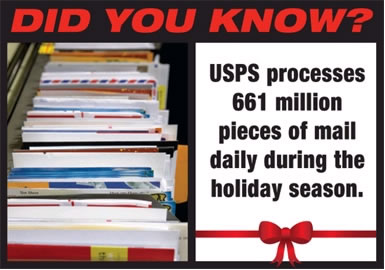
|
ARE YOU REGISTERED TO DO More than 3000 suppliers have registered since our launch of the Supplier Registration site in July 2009. All suppliers interested in doing business with the U.S. Postal Service should register their company in the Postal Service Supplier Registration system. For more information, please go to http://about.usps.com/suppliers/becoming/registration.htm. |
CONTACT US! We value your questions and feedback to this newsletter. Please feel free to reply to this message with your feedback or mail to: US Postal Service |
|
If you prefer not to receive future issues of re:supply from the U.S. Postal Service, please contact SMCommunications@usps.gov to stop future e-mails. |
|
The Postal Service receives no tax dollars for operating expenses, and relies on the sale of postage, products and services to fund its operations.
